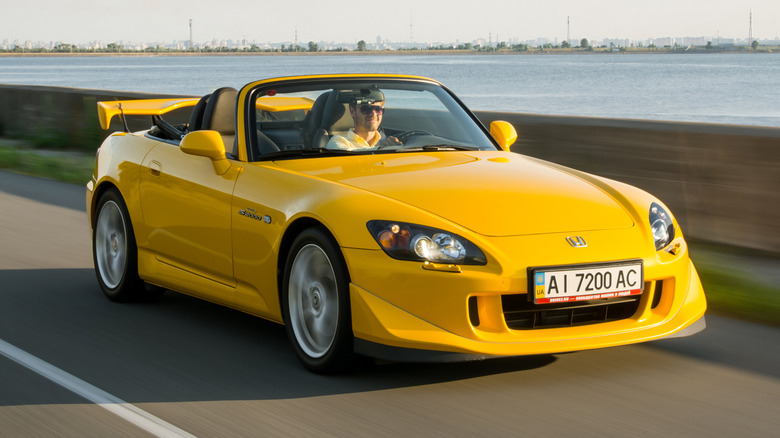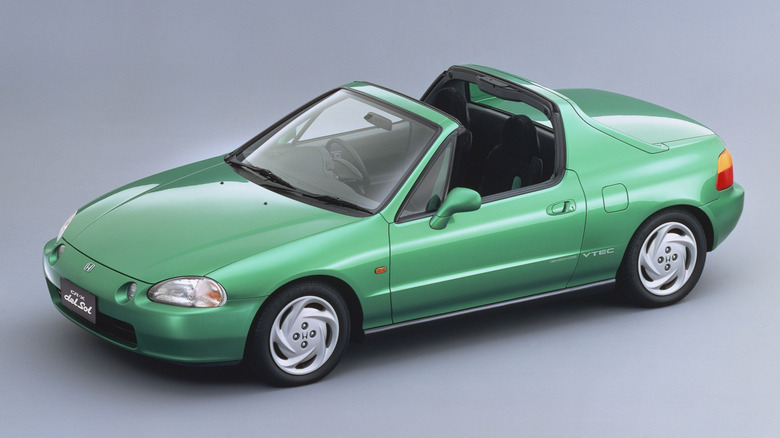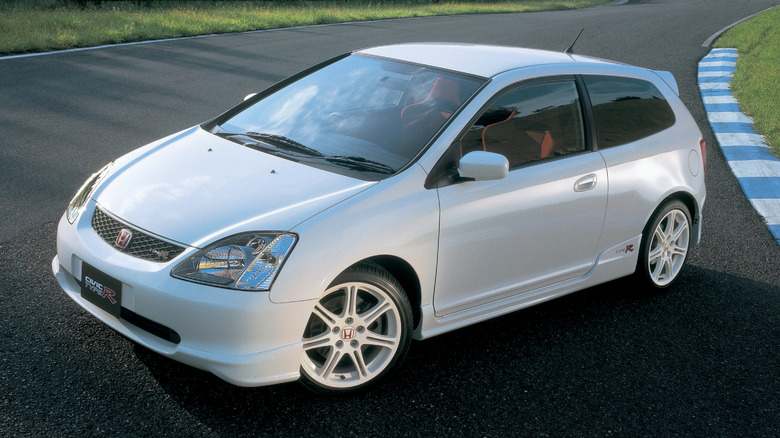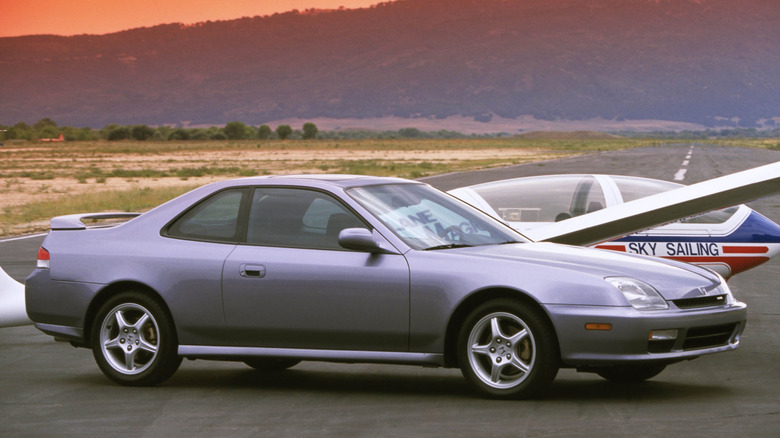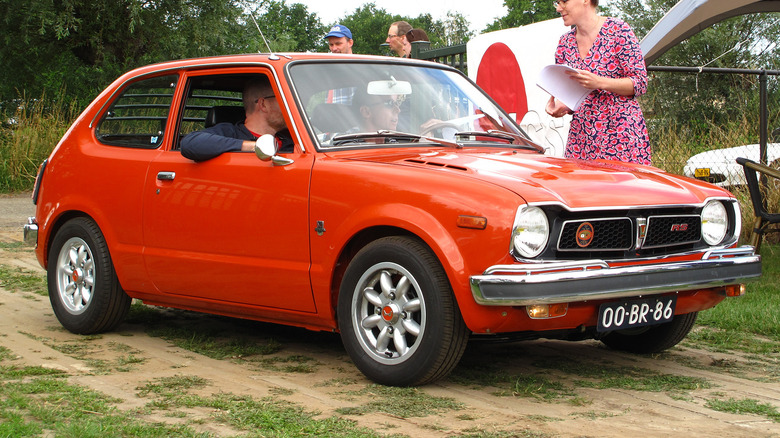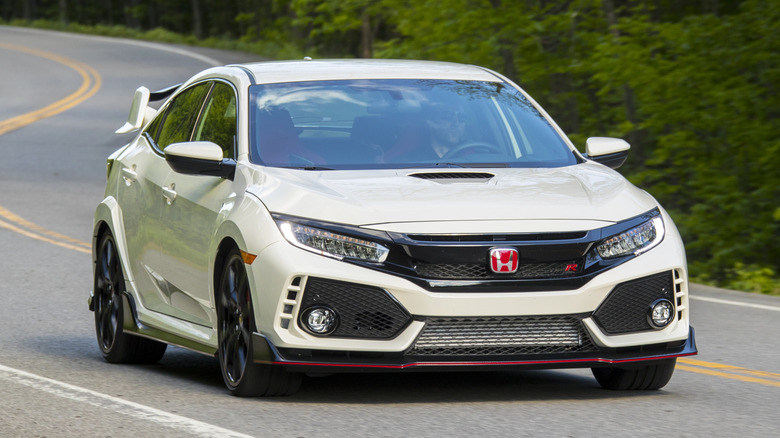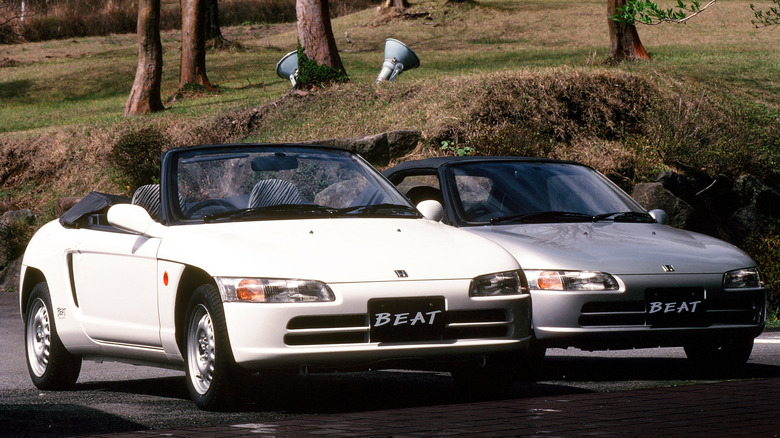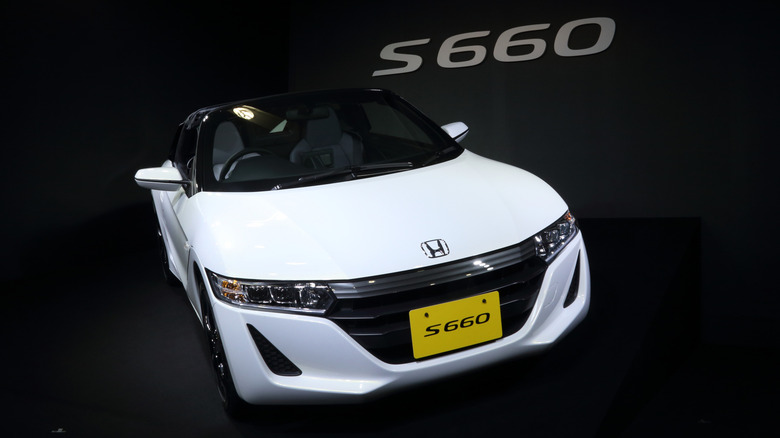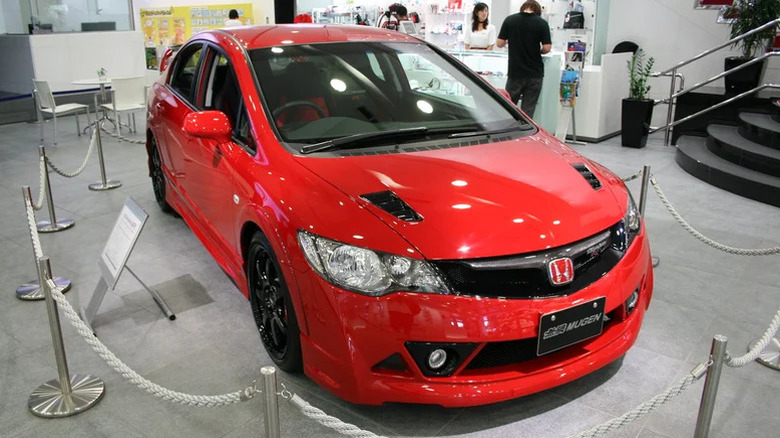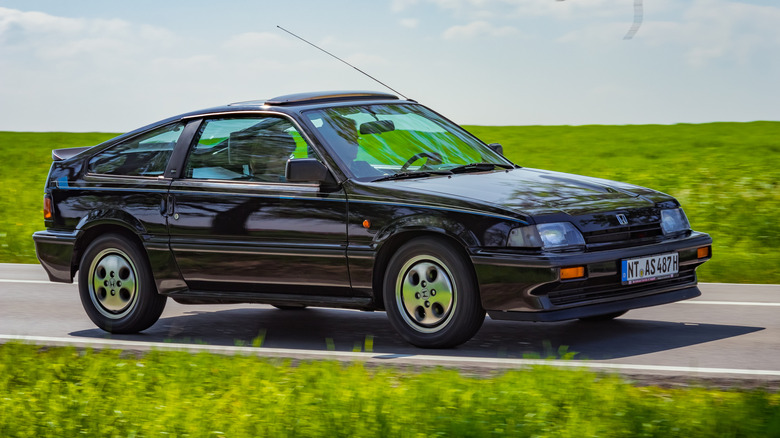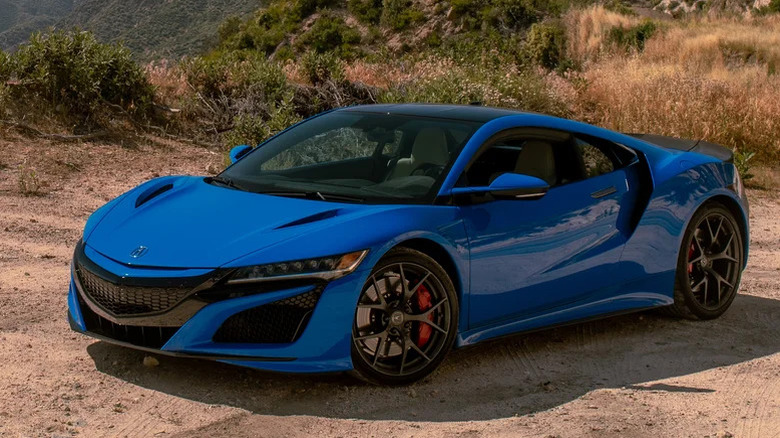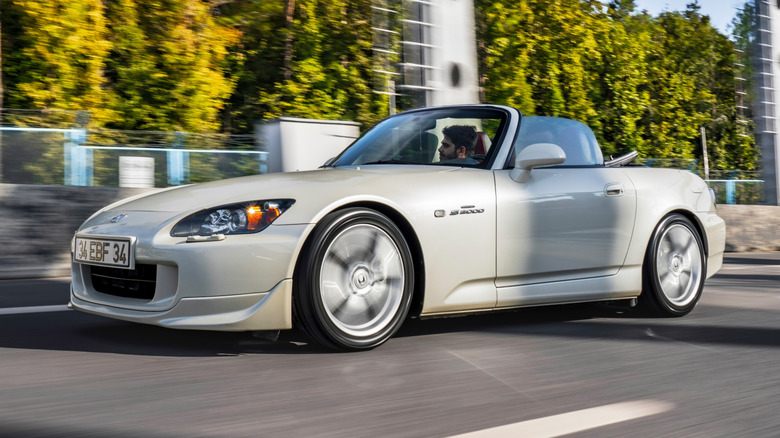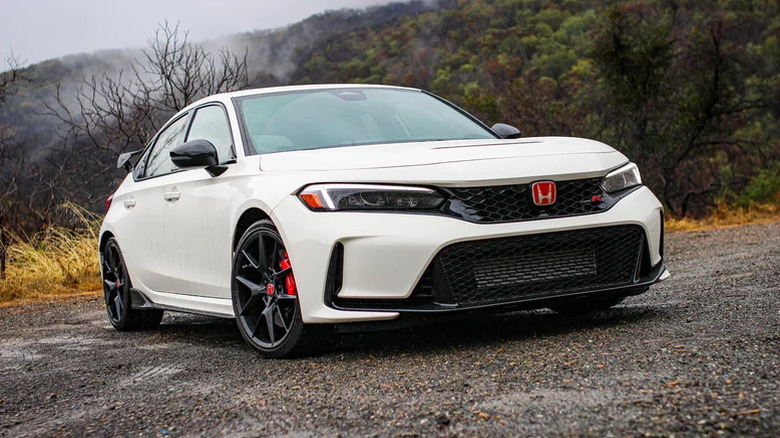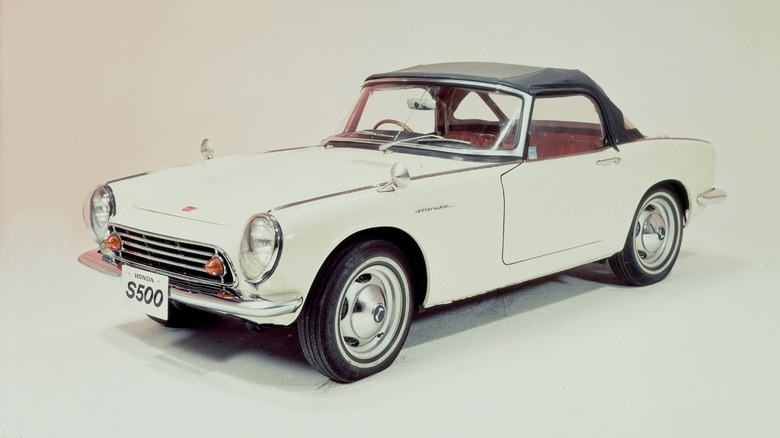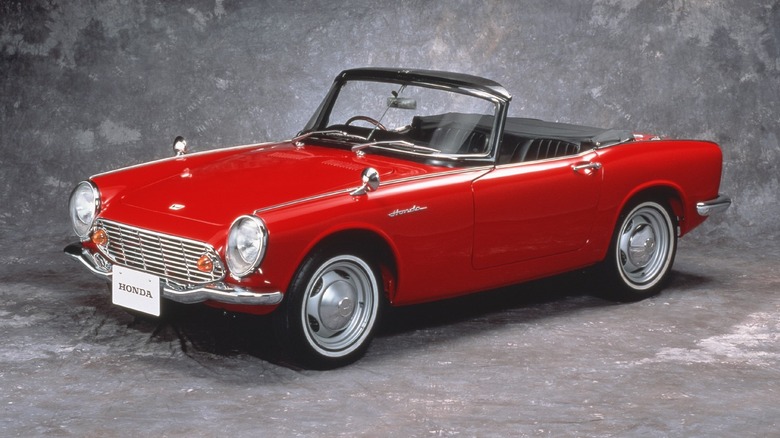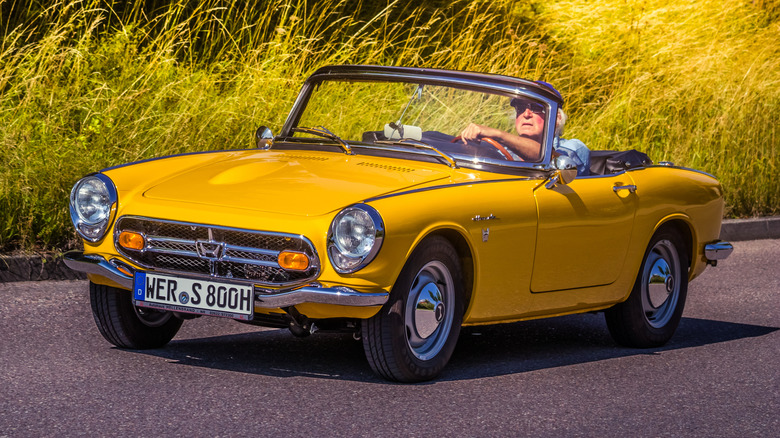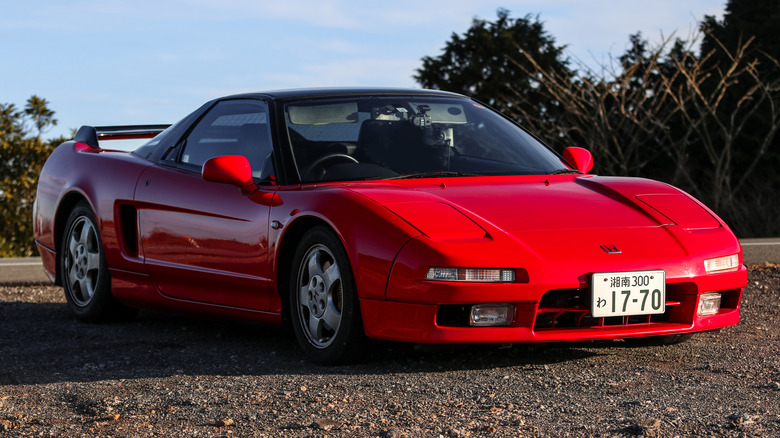18 Of The Best Honda Sports Cars Ever Made, Ranked
Ever since it first began making passenger cars in the '60s, Honda has been churning out sports cars. Its early exterior designs might have taken inspiration from European rivals, but the engineering processes behind each one were thoroughly Japanese, and that made them stand out from the rest. Over the decades, those processes have been refined and new ones developed, keeping Honda on the bleeding edge of sports car development.
From the now-discontinued second generation NSX supercar to the upcoming hybrid Honda Prelude, the brand shows no sign of slowing that development either. Yet, the industry as a whole is changing, and electrification will undoubtedly play a bigger role in the brand's future cars. Honda executives have already revealed that the brand's first all-electric sports car is in the works, although details remain scant as of this writing. So, Honda's future sports cars might look very different to those from its past, but for now, we think these 18 models represent the best of the brand's output so far.
18. 1992-1998 Honda Civic Del Sol
While it couldn't quite match up to its predecessor, the Honda Del Sol is still a quirky sports car that deserves more recognition than it gets. Called the Civic Del Sol, CR-X Del Sol, or simply CR-X, the targa-topped car was Honda's follow-up to the CR-X of the '80s. The original CR-X won over enthusiasts with its lightweight, stripped-back design and engaging handling, and remains one of Honda's best-loved sports cars today. In contrast, the Del Sol was heavier and less sharp to drive, although it boasted decent power for its price at the time.
It was first unveiled in 1992 and went on sale for the 1993 model year, but it was discontinued in the U.S. after 1997 due to slow sales. Global sales ended a year later. Part of that was down to the Del Sol's reputation for being unreliable compared to other Honda models, with its targa roof being a particularly infamous weak spot. In addition, the Del Sol had plenty of tough competition, with the Mazda Miata and Toyota MR2 offering superior handling and none of the reliability woes of the Honda. That mixed reputation has stuck with the Del Sol today, but the flip side of that is that it's still cheaper to buy than many of its '90s Japanese peers.
17. 2001-2006 Honda Civic Type R (EP3)
One of the best-loved engines in Honda history made its debut under the hood of the EP3 Civic Type R in 2001. The K20 can today be found in everything from the Ariel Atom to the Honda HR-V crossover, but at the launch of the EP3, it was all-new. It would quickly come to define the car, with its high-revving nature and unshakeable durability making the EP3 Type R an instant classic. It wasn't without its controversies, with some reviewers at the time disliking its styling and its steering being far from exemplary.
Still, the EP3 solidified the Civic Type R as a force within the hot hatch world, not least because it was the first generation to be sold outside of Japan. It was sold in both Europe and Japan and built at Honda's facility in the UK, with around 33,000 examples sold between 2001 and 2005. Unfortunately, Americans didn't get to experience the K20 engine's charms at the time and would have to wait until the launch of the FK8 Civic Type R in 2017 for the nameplate to be available stateside.
16. 1997–2001 Honda Prelude Type SH
Combining old-school handling with a rev-happy engine and typical turn of the century Honda build quality, the Honda Prelude Type SH is one of Honda's many unrepeatable sports cars. It's unrepeatable not just because modern safety and emissions regulations would not allow such a car to be made today, but because expectations for how a car behaves have changed dramatically since its unveiling.
At the time, the Prelude Type SH was considered one of the best handling front-wheel drive cars around, but in contrast to Honda's modern performance cars, it suffers significant understeer and offers much less steering responsiveness. The 200 horsepower available from its 2.2L four-cylinder engine is also a relatively modest figure by today's standards, although it was considerably more impressive at launch.
The Type SH would end up being a last hurrah for the Prelude, having been introduced in 1997, facelifted in 1999, and then discontinued in 2001 when Honda axed the Prelude nameplate. However, very soon the Prelude name will return, with the automaker targeting a 2026 launch date for the car. Even better, it's been confirmed to be coming to the U.S., but until then, the Type SH remains arguably the ultimate iteration of the model.
15. 1974-1975 Honda Civic RS
While it would take several more decades for the iconic Type R badge to first appear on a Civic, the first Civic sports car appeared in 1974, just a few years after the nameplate's launch. The Civic RS was created to appease drivers who had previously owned the brand's early sports cars, and wanted an equally sporty model.
For a few years after the launch of the Civic in 1972, Honda didn't have a proper sports car in its lineup, but the Civic RS fixed that. It offered 75 horsepower from its 1.2L four-cylinder engine, which was more than Honda's previous dedicated sports model, the S800 roadster. Plus, the Civic RS still retained the practicalities of the hatchback Civic. It was the first iteration of the formula that has today evolved into the formidable Civic Type R.
Despite being a seminal model in Honda sports car history, the Civic RS was short-lived, with 20,000 examples built over just two years. It's not known exactly how many of those survive today, but the number is thought to be a tiny fraction of the original production run. Honda launched the improved Civic CVCC in 1975, but didn't launch a second generation Civic RS model.
14. 2017-2022 Honda Civic Type R (FK8)
At its launch in 2017, the FK8 Civic Type R was the most globally available generation of the car ever built. Previous generations had been available in Europe and Japan, but for the first time, the Civic Type R was also officially sold in the U.S. market too. SlashGear drove it at its launch and deemed it "worth the wait," particularly since its $33,900 starting price kept it well within attainable territory for enthusiasts.
The FK8 was the most powerful Civic Type R to date, with over 300 horsepower on tap from the car's 2.0L engine. Like previous iterations, there was no automatic transmission or sedan version to be found — Honda might have launched the car in America, but it had no intention of Americanizing its global hot hatch. The car was also a record breaker, setting the fastest time for a front-wheel drive production car at the Nurburgring. That combination of wider availability and unprecedented performance made it a hit both commercially and critically, and by the time it was discontinued in 2022, the U.S. had become the biggest market for the car.
13. 1991-1996 Honda Beat
Making a sports car that conforms to Japan's kei car regulations is no easy task, but that hasn't stopped Honda and several other Japanese carmakers having a go over the years. Honda's earliest mid-engine kei sports car was the Beat, which was unveiled in 1991. It's considered part of the ABC trio of kei sports cars, alongside the Autozam AZ-1 (A) and Suzuki Cappuccino (C). The Beat's engine was an unusual design, being just 660cc in displacement and churning out 64 horsepower to fit within kei rules.
Unsurprisingly given its modest power output, the Beat wasn't particularly quick. However, since that peak output only arrived at a whopping 8,100 rpm, it didn't need to be. The fun of driving the Beat came from extracting every bit of its power while remaining at legal speeds, and pushing the engine to far higher revs than virtually any other road car in the process. It remained exclusive to the Japanese market throughout its production life, with the last example built in 1996 after 33,600 units had been sold.
12. 2015-2022 Honda S660
Honda's history of making tiny sports cars goes all the way back to its earliest days, but the S660 is the most recent of the bunch. It was launched for the 2015 model year in Japan only, although there were rumors that, at one point, an export version of the car was in development. That global market version never arrived, and the JDM S660's modest performance stats made it unsuitable for sales outside of its home territory — as a kei car, it was limited to just 63 horsepower and a 660cc engine.
Acceleration was, as expected, relatively modest, although, with such little weight to haul around, the S660 could hold its own against bigger sports cars in the corners. The engine itself was mid-mounted for optimal weight distribution, and the sole transmission option was a six-speed manual. It might be very much a niche sports car designed for Japan's tight, winding roads, but it proved to be popular, with over 30,000 examples sold by the time it was retired in 2022.
Much like its predecessor, the Honda Beat, the S660 is likely to become a cult classic as the decades pass. For now, it remains an affordable, pint-sized roadster that exemplifies the back-to-basic driving experience that so many enthusiasts yearn for.
11. 2007 Honda Civic Mugen RR
Most of Honda's greatest sports cars are well-known among enthusiasts, but there are a handful that many might not know about. The 2007 Honda Civic Mugen RR is a great example, since it was limited to 300 examples and was only sold in Japan. Mugen is Honda's in-house motorsports and tuning arm, and up until the release of the Civic Mugen RR, it had worked on various aftermarket Honda parts and developed the automaker's F1 engines. The Civic Mugen RR was the first time that Mugen had unveiled a complete car.
This was far from an ordinary Civic Type R with a body kit. Mugen boosted the car's output by 15 horsepower compared to the Type R, by creating a unique cam profile and tweaking the exhausts and air intake. The car also boasted unique suspension, wheels, and tires, with the latter being bespoke units developed in collaboration with Bridgestone. Performance Brembo brakes, custom Recaro seats, and weight-saving aluminum and carbon composite body panels completed the list of upgrades.
10. 1985-1991 Honda CRX Si
It might not have been the fastest or most hair-raising car of its day, but the many unique features of the Honda CRX Si have ensured it remains a collectible classic long after its contemporaries were forgotten. The CRX was based on the underpinnings of the Civic but featured sportier styling inspired by the Zagato-designed Alfa Romeo Junior. The Si was the range-topping variant, with the U.S. market version of the car making 91 horsepower.
It also came with plenty of extras over the standard CRX, including a sunroof and rear window wipers. Small additions for sure, but ones that proved to be enticing to buyers, as the Si became a sales hit when it debuted in 1985. It remains the most collectible variant of the CRX, and like many Japanese classics, resale values are rising.
However, prices remain affordable for now, with clean examples available from around $15,000 and modified or project examples available for even less. Perhaps that's only fitting, as the Si cost just $7,999 new, making it cheaper than most of its rivals yet arguably more fun to drive than any of them.
9. 2016-2022 Honda NSX (NC1)
The second-generation Honda NSX, sold under the Acura brand in North America, was a controversial car. It had a lot to live up to — the first-generation NSX is regarded as one of the most influential Japanese cars of its era. The new car offered a mix of tech, practicality, and performance with its hybrid drivetrain and plentiful driving assists, but it fell flat in the eyes of some enthusiasts.
However, after spending some time driving the car through the mountains of California, SlashGear concluded that the naysayers were simply wrong about the NSX. Its accessibility is what differentiates it from the rest of the supercar crowd. It's addictively easy to drive at full throttle, yet it's comfortable enough to make sitting in Los Angeles traffic a bearable experience.
Ironically, much like its predecessor, it might take years yet before the second-generation NSX's legacy is fully understood. After all, the hybrid powertrain and driving assists that caused so much debate when the car was unveiled are now standard in almost every supercar. For now, though, the NSX remains an underappreciated gem.
8. 1997-1999 Honda Civic Type R (EK9)
The first Civic to wear the Type R badge was the EK9, and even though its performance isn't exceptional by modern standards, it's undoubtedly one of the best hot hatches of its era. Its 1.6-liter engine produces 182 horsepower, nearly double what was on offer in the base spec Civic at the time. That engine was designed especially for the Type R, with peak torque arriving at 7,500 rpm and peak horsepower at 8,200 rpm. This was a car that begged to be driven hard, and many owners did. As a result, there are relatively few survivors in pristine condition today.
The first generation of the Type R was only ever sold in Japan, although several examples have found their way to various export markets in the decades since its release. Around 16,000 units were sold over the original production run, but many have since been claimed by rust, wear and tear, accidents, or a combination of all three. It might be a rarity, but it's well worth searching out for anyone looking for the ultimate JDM hot hatch. It might look relatively unremarkable from the outside, but the original Type R is anything but.
7. 1999-2009 Honda S2000
It wasn't just the high-revving engine that made the Honda S2000 so special, but then again, few modern mills come close to delivering such a unique driving experience. The engine wasn't universally liked at launch, mostly because it lacked power at lower revs, but the later 2.2-liter engine went some way to addressing the shortcomings of the 2.0-liter. Still, some journalists and enthusiasts weren't happy, but perhaps that was inevitable when the S2000 was so unlike anything else on the market at the time.
It needed to be pushed to the upper echelons of its rev range to be at its best, and inevitably that meant it was best suited to long, winding roads rather than highways or, even worse, urban traffic. However, find the right stretch of road, and the S2000 comes to life. Like many aging sports cars, it has its fair share of quirks that buyers should beware of, but it's proven to be one of the most reliable sports cars of its era when looked after properly.
6. 2023-Present Honda Civic Type R (FL5)
The latest and greatest version of the Civic Type R continues to be just as potent as its predecessors, with 315 horsepower and 310 pound-foot of torque available from its 2.0-liter turbo-four engine. The original EK9 Type R was a track day weapon, and the latest FL5 does nothing to change that, even in the wet conditions of our test drive. It's equally adept on the road, striking the balance between performance and everyday comfort.
The six-speed manual transmission was a particular highlight during SlashGear's time with the car, being both unrelentingly smooth and easy to master thanks to the rev-matching assist. At roughly $43,000, the Type R is not what most people would consider a bargain — this is still a Civic, after all — but it's well worth the price of entry for anyone looking for a track day toy that's equally comfortable doing daily driver duty.
5. 1963-1964 Honda S500
Honda's first-ever passenger car was a sports car called the S500. Incidentally, it debuted at the 1962 Tokyo Motor Show just across the floor from Toyota's first sports car, the Sports 800. Its name came from its engine displacement, which measured 492cc in the original prototype but was later enlarged to 531cc for the production car. To drum up publicity for the car's launch, Honda created a competition for the public to guess the starting price of the new car, which garnered over 5 million entries. Predictably, the price was lower than most envisioned, at ¥459,000 (roughly $16,250 in today's money).
The success of the S500 encouraged Honda to further develop its "S" sports car line, alongside developing larger cars for both the Japanese and the American markets. Although later models in the S-line would eventually become available around the world, the S500 never ended up being sold outside of Japan, making surviving examples tricky to find today. On the rare occasion one does change hands, it can fetch north of $50,000.
4. 1995-2001 Honda Integra Type R (DC2)
Honda's back catalog of front-wheel drive sports cars is arguably one of the greatest of any carmaker, and no car epitomizes that greatness more than the DC2 Integra Type R. It's considered by many to be among the best handling front-wheel drive cars ever produced and, yet, it sports a relatively modest power output of 187 horsepower. Its secret is its lightweight and stripped-back design, with almost nothing included in the car that doesn't need to be there. Well, that and a sprinkle of whatever chassis magic Honda's engineers managed to concoct back in the '90s.
Like many sporty Hondas, the Integra Type R proved very popular with the modding crowd, and clean, stock examples are in increasingly short supply. Those that remain pristine command a premium on the resale market, but they're still not out of reach, at least not yet. The Integra Type R is a must-drive car for any JDM fan, Honda fan, or front-wheel drive connoisseur. In fact, anyone that gets the chance to get behind the wheel of one certainly should do.
3. 1964-1966 Honda S600
While the S500 can be credited as the first ever Honda sports car, the brand's first mass-produced sports car was its successor, the S600. Over its production run, Honda only managed to build around 1,300 examples of the S500, but around 11,000 examples of the S600 left the factory between 1964 and 1966. The S600 sported several notable engine improvements over its predecessor, with a larger, more potent 0.6L mill, making 55 horsepower. Reinforced components were also added for added reliability.
One such part was a hose near the carburetor, which was reinforced after its weakness was discovered while a Japanese journalist was taking the S600 on a promotional tour through Europe. This tour, along with Honda's appearance at some of the biggest European sporting events on the calendar, helped significantly boost Honda's brand awareness on the continent. The automaker would continue to refine the design of its flagship sports car with the launch of the S600's successor, the S800, in 1966.
2. 1966-1970 Honda S800
An evolution of the S500 and the S600, the S800 saw Honda's little sports car line go global. The car was sold in Western export markets as well as in Japan, with its 791cc engine remaining unchanged across all markets. That engine only produced around 70 horsepower, but considering the car weighed just 1,700 pounds, it was still sprightly to drive.
It sported a very distinctive soundtrack in part thanks to the engine's 8,500 rpm redline. Its initial design was heavily inspired by the British sports cars of the era, and at a glance, it might not look all that different, but it was under the hood where the real innovation lay.
The diminutive roadster was to be the last in the initial run of S-line sports cars, with its eventual successor, the S2000, not breaking cover until the late '90s. The S800 was discontinued after 1970, but many Hondas over the following years took influence from the car's design and high-revving nature.
1. 1990-2005 Honda NSX (NA1/NA2)
Perhaps Honda's most influential model in terms of how it shaped the rest of the sports car industry, the original NSX was a real groundbreaker when it launched in 1990. Its design and versatility heavily inspired the design of the McLaren F1, its performance forced Ferrari to up its game with the F355, and its headline-grabbing status helped establish the Acura brand in America. With all that in mind, it's no surprise that prices for the car are on the rise as demand from collectors increases and the supply of clean examples diminishes.
The NSX's design was inspired by the F16 fighter jet and looked unlike anything else on the market at the time. Its construction was similarly cutting edge, with an aluminum monocoque chassis used to reduce weight without compromising on rigidity. Performance was also impressive for the era, even if it doesn't look so today.
Arguably the biggest achievement of the NSX was that it forced other carmakers to innovate. With such a futuristic, versatile car on sale, Honda's rivals were instantly dated in comparison. Over the following years, a period of intense development followed that saw, among many other things, the birth of the hypercar. But, things might not have panned out that way were it not for the launch of the NSX.
